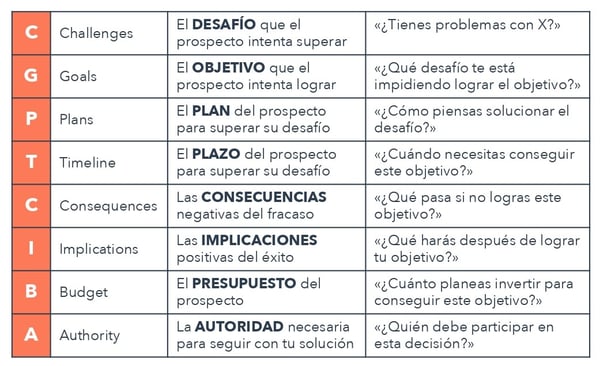Index Content
We explain how to deal with calls with your prospects in the exploration stage using the CGP, TCI, BA method
Achieving inbound sales that focus on personalised help over the desire to sell can be hard work. But it is easier if we accompany each potential customer through the four stages of this process: identification, connection, exploration and advice. In this article, we will focus on the third stage, which aims to understand the user's context and guide them. And for this, the best way to do it is to use the CGP, TCI, BA method.
This working method is focused on B2B sales (although it also works for B2C) and offers a complete guide to establish phone calls with your potential customers. In the image below you can find a table with all the phases of this method created by HubSpot Academy. We recommend you to have it in front of you during your conversations and take notes to continue working in depth later. Below, from OCCAM we present an outline of how you should structure your calls following the CGP, TCI, BA method. Let's start!

-
preliminary phase: start the call before starting the CGP, TCI, BA method
Like a book, it is important to start the call with a short introduction. The aim is to create a pleasant atmosphere and not to start the conversation directly with the strong topics. To do this, you can use these three tips:
- create a bond: After the initial greeting and introductions, it is a good idea to ask a light-hearted question that brings you closer to the customer. To do this, do some research in your CRM or on social networks to find out their interests and adapt the tone of the call to their profile. This will serve as a brief introduction and will give a sense of trust and interest.
- review what you have learned from other conversations. Prior to this call, you will have been in contact with the prospect before during the connection stage. Remember what you talked about in those moments and start the new call where you left off.
- explain the plan for the call. Give the customer a roadmap of how the conversation will unfold so that they know what to expect. Ask them if they agree or if they have time to address all the necessary topics.
-
cGP method: talk about challenges, goals and plans
Now it's time to apply the CGP, TCI, BA method starting with the first three letters, which stand for challenges, goals and plans. Let's look at how you should approach each of these parts of the conversation:
- challenges (C): What obstacles is the customer facing? If you are having a conversation with him, it is because he has challenges to overcome. This is the time to address them. Ask him about this issue and adopt an active listening process to understand the problems he is experiencing. You will then be able to deal much better with the rest of the call.
- objectives (G): What does the client want to achieve? More important than knowing their specific objectives is understanding the challenges that are preventing them from achieving their goals. Remember that your job is to solve those problems, and to do that you must be able to help them with their objectives. So when the client tells you their fundamental objective, ask them questions to quantify it. This will give you an understanding of the scale of the challenge you may face and pave the way for further discussion of budget.
- plans (P): How does the client intend to overcome their challenges? Before offering solutions, make sure you understand your client's ideas for achieving their goals. Your job here is to make them understand that their plans are not entirely effective. You should then ask them if they are willing to take on a different strategy with your help.
-
tCI method: discuss timelines, consequences and implications
Once you have dealt with the first part, you can move on to the TCI phase, which stands for timeline (timeline), consequences ( consequences ) and implications (implications):
- timeline (T): How much time does the client have or want to invest in achieving their objectives? Find out if the plans are urgent or can be addressed in the long term. Ask about the deadline and explain whether it is feasible or not, as well as the steps needed to develop a solution.
- consequences (C): What negative effects might the client encounter if he does not solve his challenges? Try to make him understand the problems he can save himself with your help.
- implications (I): What benefits will the client find from adopting a change in their plans? After addressing the consequences, it is important to return to a positive tone by talking about a hypothetical situation where the problems have been solved.
-
bA method: talk about budget and authority
The CGP, TCI, BA method ends with the last two letters, relating to budget and authority:
- budget (B): How much will it cost the customer to meet the challenges to meet their objectives? Remember to approach this part of the call from the perspective of your caller, not your company. Explain how much it will cost, not how much you will charge. Analyse this investment in the light of everything you have discussed previously. Talk about the money they stand to lose if they go ahead with their plan or the cost effectiveness of investing in a different strategy. But don't jump in and offer a sale before checking whether the prospect is prepared to meet the expense you are proposing.
- authority (A): Who is the person in charge of making the final purchase decision? Your contact may not be the ultimate decision-maker, so when there is a firm commitment between the two parties, ask about this.
-
final stage: close the call with a review
Once all the questions regarding the exploration stage have been addressed, it is time to say goodbye. But before that, we recommend using one of the following techniques to close the call in an even more satisfactory way:
- ask the prospect what conclusions they have drawn from the call.
- ask them what they think you should do next.
- make a complete summary of the conversation based on the CGP, TCI, BA method, so that the client can reflect again on his situation and check that you are both on the same page.
now you know all you need to know about the best way to guide your prospects, and it's time to put what you've learned into practice to guide them to the last phase of inbound sales: the consulting stage.





